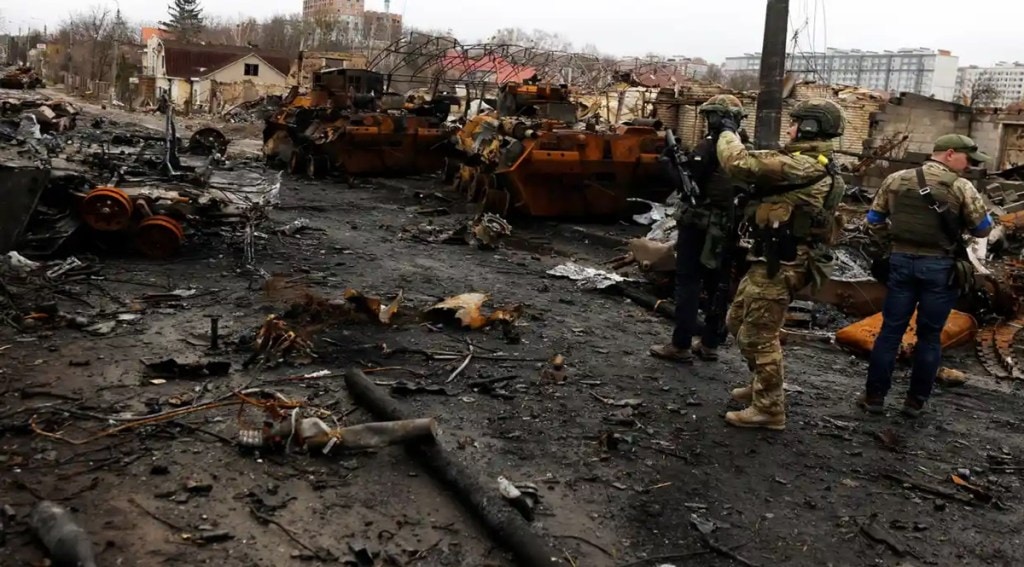By Prashant Dikshit
The Russian troops had to withdraw from the outskirts of Kiev having been stopped in their tracks by the Ukrainian forces, which were now waging a Guerilla War on the invading troops. They were very successfully using anti-tank weapons supplied by the US and the NATO allies. Similarly, the US supplied, shoulder fired FIM –Stinger SAMs had come into play which seemingly neutralized all application of air power by the Russian Air Force. Although, the Ukrainian armed forces had been weakened with the war of attrition waged by the Russian army in which they had lost many of their air defence installations and missile launch platforms.
Having sunk the Russian missile carrying “warship Moskva, the 600-foot, 12,500-tonne flagship of the Russian Black Sea Fleet — with a missile strike” is a morale booster for the Ukrainian armed forces and a serious setback for Russia in terms of strategic control over the black sea. The Russian claim that it was caused by a fire on board is not tenable is in view of Naval experts.This missile boat was largely responsible for launching “ Kalibre” missiles on the targets in Ukraine and was a target which necessarily needed to be neutralized.
The Russian campaign at the city of Mariupol however, the main port of eastern Ukrainegoes unabated although as the news came in on 18th April, nearly a brigade strength of deeply entrenched Ukrainian fighters are holding on. Replenishment and logistics would be difficult as the Russian troops have surrounded the city. Mariupol and areas surrounding the port city have now come into principal focus.Russian attacks have destroyed an oil refinery near the key port city of Odessa. This region, we would recall, was always of strategic interest to Russia as it would provide over land access to the Crimean Peninsula through the northerly Donbas region which is already under Russian control and influence in the guise of a separatists led state.
And at the outset this is what the Kremlin regime wanted.
This brings us to the point where we should ponder as to why the Russian War Machine had to go racing towards Kiev , destroying large urban centres in its wake. Was the objective to change the regime in Kiev and replace it with leadership amenable to Russians in doctrines and remain under the Russian sphere of Influence?
There are several parallels to this syndrome. The Soviet incursions in Warsaw pact countries and most recently in Georgia in 2008 where with intense military action Russia subjugated Georgia and engineered a change in regime. Here also the issue of inclusion into NATO was the catalyst for the conflict and separatist movements in northern Georgia provided the means.
The US and its NATO allies in Europe have resorted to an all pervasive sanctions regime against Russia in the belief that it will bring Russia to heel and greatly help in stopping the armed conflict in Ukraine. Experts believe that it is not likely to happen in the near future. Economists foresee a good three years period when Russian people will feel the impact of sanctions.
In a prominent paradox, Russian gas continues to be used extensively in European countries as they have no viable alternatives. Moreover, faced with dollar restriction the Russians are now seeking payments in Russian ruble. Driven by its own national interests, India has also chosen to avail of the Russian gas to meet its energy needs. Reacting to some adverse comments on that score, the Indian Minister of External Affairs stated that “If you’re looking at(India’s)energy purchases from Russia, I’d suggest your attention should be on Europe. We buy some energy necessary for our energy security. But I suspect, looking at figures, our purchases for the month would be less than what Europe does in an afternoon”. In fact, the Ukrainian section of this gas pipe has a length of 1,120 kilometers and has a capacity of 28.5 billion cubic meters. It has remained untouched by all essentially driven by self-interests.
It is about time we looked at global interests specially of smaller countries who are at the receiving end of crisis with deep financial impact on their people. Sri Lanka , India’s neighbour reels under a severe economic and energy crisis . There is acute fuel shortage. Nepal in the North has already introduced rationing of fuel by stopping all vehicular movements two days in a week and foresees an economic depression in the horizon.
It has come to light that “Major supplies of sunflower oil come from Ukraine, and 13% of India’s export of tea went to Russia. India is also a significant importer of phosphatic fertilizers from Russia.” Similarly the jump in global fuel prices since the beginning of the conflict in Ukraine has only added to challenges being encountered by countries in South East Asia. Most of us in the developing world are recovering from a debilitating impact of the pandemic and the Ukraine war is a double whammy.
In these circumstances, India can truly play a very constructive role in persuading Russia to take a visionary role in the global affairs and dissuade itself from following a hostile route to its destiny. Perhaps the next meeting of the BRICS, likely to be held in June 2022 and to be hosted by the Chinese regime, may lead to a thaw in the Russian attitudes towards Ukraine.
(The author is a strategic affairs commentator. Views expressed are personal and do not reflect the official position or policy of Financial Express Online. Reproducing this content without permission is prohibited).

